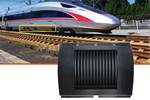Composites to target indirection emissions reduction in U.K. rail sector
Composite Braiding’s Steve Barbour suggests ways to further decarbonize the U.K. rail industry through increased composites adoption.
The path toward sustainability and net zero, as we know, comes in many forms and addresses most industries in manufacturing. According to the U.S. Environmental Protection Agency (EPA), as of 2022, the transportation sector is the largest source of direct greenhouse gas emissions at 28%. Nevertheless, there are ways to actively improve these numbers through the use of composites, which Steve Barbour, managing director of Composite Braiding (Derby, U.K.), further explores in an opinion article published in The Engineer.
Barbour’s column centers around decarbonization efforts in the U.K. He says that when it comes to transportation methods, overall, trains are considered the least emissions-intensive mode of passenger transport over the region’s transport emissions total — at least when it comes to direct emissions, or the “physical burning of petrol or diesel and the related greenhouse gases.” Indirect emissions, however, related to manufacturing, construction, infrastructure maintenance and the supply chain, are a different kind of challenge that need to be addressed.
When it comes to materials and maintenance solutions, Barbour says, composites are a clear contender. While more energy-intensive to create versus metallic options, he cites their 70% reduction in density when compared to steel — contributing to savings across the structure’s entire life cycle, from enabling easier transport and assembly, to the need for less maintenance.
Barbour suggests using composites for critical rail infrastructure pieces like lighting and communications masts and bridges, as well as train frames, racks and grab poles. He also notes that the braiding process significantly cuts down production time and energy use — the latter by up to 98%.
“Creating composites through braiding, a process whereby thermoplastics are woven into their final forms in a highly automated process, results in much lighter, low-cost materials with significantly lower production times and labor costs,” Barbour says in the article. “What’s more, they are deliverable at much higher volumes.”
Read the complete article from The Engineer here.
Related Content
-
SMC composites progress BinC solar electric vehicles
In an interview with one of Aptera’s co-founders, CW sheds light on the inspiration behind the crowd-funded solar electric vehicle, its body in carbon (BinC) and how composite materials are playing a role in its design.
-
Jeep all-composite roof receivers achieve steel performance at low mass
Ultrashort carbon fiber/PPA replaces steel on rooftop brackets to hold Jeep soft tops, hardtops.
-
Plant tour: Joby Aviation, Marina, Calif., U.S.
As the advanced air mobility market begins to take shape, market leader Joby Aviation works to industrialize composites manufacturing for its first-generation, composites-intensive, all-electric air taxi.















.jpg;maxWidth=300;quality=90)
